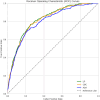Comparative performance of twelve machine learning models in predicting COVID-19 mortality risk in children: a population-based retrospective cohort study in Brazil
- PMID: 40567691
- PMCID: PMC12192853
- DOI: 10.7717/peerj-cs.2916
Comparative performance of twelve machine learning models in predicting COVID-19 mortality risk in children: a population-based retrospective cohort study in Brazil
Abstract
The COVID-19 pandemic has catalyzed the application of advanced digital technologies such as artificial intelligence (AI) to predict mortality in adult patients. However, the development of machine learning (ML) models for predicting outcomes in children and adolescents with COVID-19 remains limited. This study aimed to evaluate the performance of multiple machine learning models in forecasting mortality among hospitalized pediatric COVID-19 patients. In this cohort study, we used the SIVEP-Gripe dataset, a public resource maintained by the Ministry of Health, to track severe acute respiratory syndrome (SARS) in Brazil. To create subsets for training and testing the machine learning (ML) models, we divided the primary dataset into three parts. Using these subsets, we developed and trained 12 ML algorithms to predict the outcomes. We assessed the performance of these models using various metrics such as accuracy, precision, sensitivity, recall, and area under the receiver operating characteristic curve (AUC). Among the 37 variables examined, 24 were found to be potential indicators of mortality, as determined by the chi-square test of independence. The Logistic Regression (LR) algorithm achieved the highest performance, with an accuracy of 92.5% and an AUC of 80.1%, on the optimized dataset. Gradient boosting classifier (GBC) and AdaBoost (ADA), closely followed the LR algorithm, producing similar results. Our study also revealed that baseline reduced oxygen saturation, presence of comorbidities, and older age were the most relevant factors in predicting mortality in children and adolescents hospitalized with SARS-CoV-2 infection. The use of ML models can be an asset in making clinical decisions and implementing evidence-based patient management strategies, which can enhance patient outcomes and overall quality of medical care. LR, GBC, and ADA models have demonstrated efficiency in accurately predicting mortality in COVID-19 pediatric patients.
Keywords: Artificial intelligence; COVID-19; Children; Death prediction; Healthcare; Machine learning; Mortality; Risk.
© 2025 Lages dos Santos et al.
Conflict of interest statement
The authors declare that they have no competing interests.
Figures



Similar articles
-
Signs and symptoms to determine if a patient presenting in primary care or hospital outpatient settings has COVID-19.Cochrane Database Syst Rev. 2022 May 20;5(5):CD013665. doi: 10.1002/14651858.CD013665.pub3. Cochrane Database Syst Rev. 2022. PMID: 35593186 Free PMC article.
-
Measures implemented in the school setting to contain the COVID-19 pandemic.Cochrane Database Syst Rev. 2022 Jan 17;1(1):CD015029. doi: 10.1002/14651858.CD015029. Cochrane Database Syst Rev. 2022. Update in: Cochrane Database Syst Rev. 2024 May 2;5:CD015029. doi: 10.1002/14651858.CD015029.pub2. PMID: 35037252 Free PMC article. Updated.
-
Rapid, point-of-care antigen tests for diagnosis of SARS-CoV-2 infection.Cochrane Database Syst Rev. 2022 Jul 22;7(7):CD013705. doi: 10.1002/14651858.CD013705.pub3. Cochrane Database Syst Rev. 2022. PMID: 35866452 Free PMC article.
-
Antibody tests for identification of current and past infection with SARS-CoV-2.Cochrane Database Syst Rev. 2022 Nov 17;11(11):CD013652. doi: 10.1002/14651858.CD013652.pub2. Cochrane Database Syst Rev. 2022. PMID: 36394900 Free PMC article.
-
A deep learning approach to direct immunofluorescence pattern recognition in autoimmune bullous diseases.Br J Dermatol. 2024 Jul 16;191(2):261-266. doi: 10.1093/bjd/ljae142. Br J Dermatol. 2024. PMID: 38581445
References
-
- Aktar S, Talukder A, Ahamad MM, Kamal AHM, Khan JR, Protikuzzaman M, Hossain N, Azad AKM, Quinn JMW, Summers MA, Liaw T, Eapen V, Moni MA. Machine learning approaches to identify patient comorbidities and symptoms that increased risk of mortality in COVID-19. Diagnostics. 2021;11:1383. doi: 10.3390/diagnostics11081383. - DOI - PMC - PubMed
-
- Allenbach Y, Saadoun D, Maalouf G, Vieira M, Hellio A, Boddaert J, Gros H, Salem JE, Resche Rigon M, Menyssa C, Biard L, Benveniste O, Cacoub P, Dimicovid Development of a multivariate prediction model of intensive care unit transfer or death: a French prospective cohort study of hospitalized COVID-19 patients. PLOS ONE. 2020;15(10):e0240711. doi: 10.1371/journal.pone.0240711. - DOI - PMC - PubMed
-
- Assaf D, Gutman Y, Neuman Y, Segal G, Amit S, Gefen-Halevi S, Shilo N, Epstein A, Mor-Cohen R, Biber A, Rahav G, Levy I, Tirosh A. Utilization of machine-learning models to accurately predict the risk for critical COVID-19. Internal and Emergency Medicine. 2020;15(8):1435–1443. doi: 10.1007/s11739-020-02475-0. - DOI - PMC - PubMed
LinkOut - more resources
Full Text Sources
Research Materials
Miscellaneous
